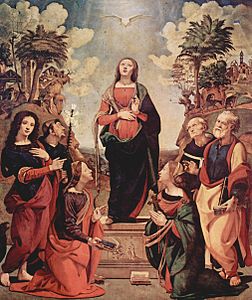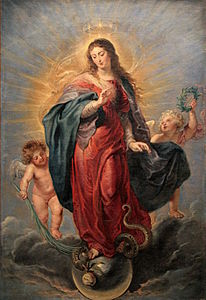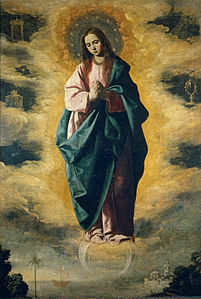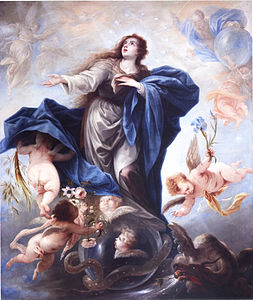Kukingiwa dhambi ya asili
From Wikipedia, the free encyclopedia
Kukingiwa dhambi ya asili ni fundisho rasmi la Kanisa Katoliki kuhusu Bikira Maria, kwamba alitungwa mimba bila kurithi dhambi ya asili na kwamba alipewa na Mungu fadhili hiyo kwa kutanguliziwa stahili za Yesu Kristo, mwanae[2]
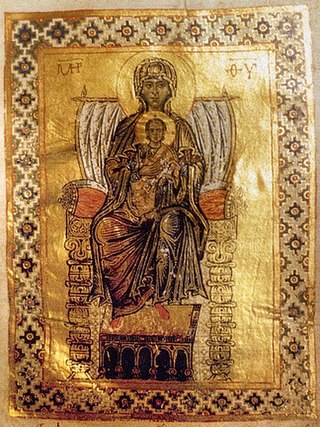
Kadiri ya imani hiyo Maria, akiwa kweli amejaa neema na mbarikiwa kati ya wanawake, kwa kutazamia uzazi na kifo cha Mwana wa Mungu kitakacholeta wokovu, tangu nukta ya kwanza ya kutungwa mimba alikingiwa doa lolote la dhambi[3].
Dogma hiyo ilitangazwa kwa fahari na Papa Pius IX kutokana na mapokeo ya kale sana [4].
Historia
Imani hiyo katika utakatifu usio na doa wa Maria ilishikwa na Wakristo tangu kale[5].
Hata hivyo mjadala wa wanateolojia uliendelea muda mrefu kuhusu uwezekano wa fadhili hiyo kuhusiana na imani ya kwamba Mkombozi pekee wa binadamu wote ni Yesu.
Kati ya watetezi wakuu wa fadhili hiyo walijitokeza Ndugu Wadogo, kuanzia Yohane Duns Skoto[6].
Hatimaye dogma hiyo ilitangazwa mwaka 1854 kwa hati Ineffabilis Deus ya Papa Pius IX.[7][8]
Miaka minne baadaye huko Lurdi mtoto Bernadeta Soubirous alisema kuwa ametokewa mara kadha na mwanamke ambaye hatimaye alijitambulisha "Ndimi Kukingiwa Dhambi ya Asili".[9]
Katika liturujia
Kanisa la Kilatini linaadhimisha fumbo hilo kama sherehe tarehe 8 Desemba[10]. Siku hiyo katika nchi mbalimbali ni sikukuu ya amri kwa Wakatoliki, na pengine sikukuu ya kitaifa.[11]

Katika Uislamu
Mafundisho ya Uislamu juu ya ubora wa Bikira Mariamu yanafanana kiasi na imani hiyo[12][13][14].
Picha
Tanbihi
Marejeo
Viungo vya nje
Wikiwand - on
Seamless Wikipedia browsing. On steroids.

